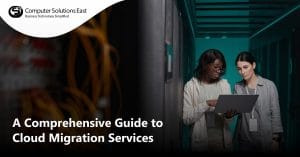Eight Steps to Ensure Compliance Before Financial Services Institutions Move to the Cloud
Cloud computing is one of the common buzzwords in the digitally transforming world used by most enterprises, ranging from small to large international companies. It has been the most opted solution for every company to replace their physical infrastructure and software management. Cloud computing is nothing but the usage of hardware and software services over the internet (network). The resources comprise many applications and tools like databases, data storage, servers, networking, software, and data security. Rather than keeping the files in on-premises infrastructure, it is stored on the cloud storage (say online) to a remote database.
The business people are interested in the new technology as it saves them high costs and improves performance in all ways. It gives unlimited access to users from anywhere and at any time, allowing them to work remotely. The company that uses cloud computing needs not worry about hardware and software management as the cloud provider maintains it. Cloud computing can be done for both public and private services according to its demands, goals, and requirements.

Microsoft Azure Service is a cloud computing platform that can provide all the services for business organizations over the internet. The Microsoft Cloud Solution will manage all the hardware and software services delivered to the company, leaving the organization to focus on its core functions. Financial institutions can take more significant advantages with this innovative technology, simplifying complex financial processes and securing colossal data and transactions. But there are some factors to be considered before migrating to the Cloud, and it should be planned thoroughly by the company before making the final decision.
Eight steps for financial institutions to consider before moving to the Cloud are:
Internal Discussion and Agreement: The first step is to discuss the migration to the Cloud with all the stakeholders, partners, and managers of the organization to see their involvement. If the gathering has brought everyone to agree on cloud migration, then the process can be initiated. Otherwise, internal disagreements and disputes may arise in the process of transition.
Determine the goals for transition: Migration to the Cloud is not an easy task. Before moving, you need to understand the exact requirement for replacing your IT infrastructure into the Cloud. In other words, define the goals and objectives for migrating to the Cloud and try to take more significant advantage of the benefit it can do to your business.
Assess your current situation and risks: The knowledge of what applications and resources you need to migrate to the Cloud and what will happen to the current IT environment during the transition area to be thoroughly assessed by the company. The main decisions are to take precisely what applications should be migrated, auditing your current infrastructure, and understanding the current cost and resource levels for improving the company’s productivity, efficiency, and security.
Selecting the reliable migration provider: The right cloud migration provider should be selected in the early stages so that the successful migration does not transform into a disaster. The partner should decide on many factors such as the types of clients they have worked with, setting the post-cloud migration experience, and verified certified consultants. Microsoft service providers (Azure), Google service providers (Google Cloud), and Amazon Web Services are known to cloud providers.
Ready with an exit strategy: The financial institutions must think of an exit strategy in the major cloud service provider failure like bankruptcy. The recovery part of the plan should be kept documented with detailed strategies in these scenarios. All the assigned responsibilities should be acknowledged to the staff and the phases, timing, cost estimates, and other factors for the recovery.
Plan the migration approach: There might be countless questions in your mind before migrating, but make sure you get answers to all that and then plan for cloud migration. The primary fears might be risk management, the order of migration (applications and environments), new cloud performance, real-time cloud archiving solutions, training required for handling the new environment, and what to do with the on-premises resources. Get formal approval before consuming the cloud service.
Notify officials and customers: After all the planning is done, executing the migration is the next step. But before that, informing all the concerned higher officials like regulators, supervisors, managers, and the ultimate leader should be done. Migration might take some time, and until that, no transactions should be done to avoid complications for the company and the customers.
Monitor the new Cloud: After a successful cloud migration, monitor the new cloud environment and check whether the tools and processes are happening at a favorable rate. The cloud app development service can be utilized for customizing any tool or application according to the company’s demand. Any issues should immediately be addressed to the admin, and the provider should take immediate action if any report is generated.
CSE is a reliable cloud service provider that can deliver the necessary knowledge and tools for migrating to the cloud environment. They will guide you throughout the process and will instantly solve issues in the post-migration period. CSE guarantees robust security, seamless transition, and 24/7 support services for every one of its users.


